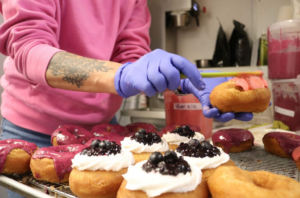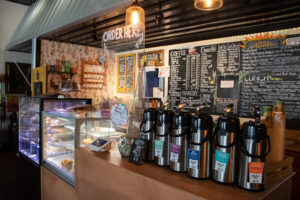Rating: C+
Stepping foot into Koba Ninja House felt like stepping into Narnia: it was dark, and I had no idea where I was. The restaurant, which makes every attempt to look like an authentic Asian establishment, looks very much like a chain Japanese restaurant in Bangor, Maine. Various Buddhist and Shinto symbols and a mix of calligraphy adorned the walls, the colors were predominantly yellow, red and black and paper lanterns hung in various locations around the dining room.
I knew this would be the case going in, and didn’t let it sway my opinion. Arriving early for a large gathering, I made my way to the bar to wait for the remainder of the guests. The bar provided a perfect vantage point for people-watching, but the activity turned ugly when a man, whom I presumed to be the owner, picked up a woman (who had consumed too many cocktails) and carried her, laughing, out of the restaurant in a strange embrace. The man then made several insults to patrons, making every attempt to joke with them, and even insulted a friend of mine on her birthday, insinuating she had booked her reservation for an inconvenient time and should have better planned the event.
He tried to make amends by gifting her a free drink, which she ultimately did not enjoy. Another friend described its flavor as that of gas station “circus peanuts” candies and, sampling the drink myself, found it resembled a boozy cough suppressant topped with whipped cream.
Putting the experience behind us, we ordered appetizers at the bar before sitting down for the main course. Appetizers ($4 to $9.50) included a variety of Japanese, Chinese and fusion foods, from pork-stuffed and pan-fried gyoza dumplings ($5.50); to a wasabi rice flatbread ($6.95), a mix of tuna, crab and avocado on crispy rice; to ribeye kabobs so endearingly referred to on the menu as just “Beef Stick,” which, needless to say, I avoided ($7.50).
Yaki tori ($6), a plate of chicken kabobs with scallions and mint, came piping hot with a sticky-sweet soy glaze and sprinkled with sesame seeds. As tender and moist as the chicken was — no easy feat with kabobs — the scallions were charred and lent no flavor, while mint was nowhere to be found. Served on a messy bed of bean sprouts, rendered inedible by our lack of silverware, the dish neither impressed in presentation nor flavor. Another appetizer, the wasabi shumai ($6.50) were a stark contrast to the yaki tori. Tender ground pork embraced by a wasabi noodle wrapper, steamed until tender and plated simply, arrived at the table with a sweet and spicy dipping sauce. The subtle kick from the wasabi gave these dumplings some life, while the sauce provided a complementary sweetness and some much-needed tang.
Sushi is available at Kobe, with many classics and several innovations offered. You could order a classic California roll for $4, or a cool Philly roll for $5. You could even order a “U-Maine Roll” ($8), a menage of salmon and red snapper, asparagus and scallion that is then deep fried and served with what is only described as “special” sauce — or you could, you know, not.
The star of the show, hibachi — which is incorrectly named, as this style of cooking is known in Japan as teppanyaki; a hibachi is actually a charcoal barbecue grill — was reasonably-priced considering its large portion sizes. From vegetable hibachi ($13), to a range of proteins including chicken ($17) and a filet mignon and lobster tail combination ($31), there was something for everyone. Each hibachi entree came with a green salad, clear dashi soup, vegetable fried rice and a shrimp appetizer.
Quite frankly, it’s a bang for your buck. But only if you like it.
The green salad in of itself was a weak attempt at a starter course, with pale iceberg lettuce, and each a single tomato and cucumber slice haphazardly thrown into a ramekin-sized bowl. The salad’s saving grace was a sweet and creamy ginger dressing that luxuriously coated the greenery beneath. The salad was not necessary; a bowl of dressing would have sufficed. The clear soup, a light dashi broth adorned with a couple or, if you were lucky, maybe a few mushrooms of unknown variety and some chopped chives, was refreshing and, sure, good — but I found it utterly pointless.
Come the main event, the rousing spectacle in which our chef would not only prepare our food at our table, but set many things on fire in the process, I was tired and ready to leave. But once the eggs hit the griddle, I perked up once more. The chef lit the griddle and a friend asked our chef if he had any formal training as a hibachi chef.
“This is my second day,” he jokingly replied. Clearly, he had experience.
The chef doused the griddle with sake and flames shot to the ceiling, as the chef then began to pour sake shots for the table. Several guests threw their sakes back as as the chef’s knives and spatula began chopping and frying in an elegant dance of fire and twisted metal. He tipped eggs onto his spatula and cracked them against the flat-top, purposefully dropping an egg for a laugh. Then he threw on the rice, added soy and more seasonings and heaped the fried rice onto our plates.
Previous experiences at restaurants of this type have taught me that the rice is typically cooked in shortening, which I find leaves an unpleasant chemical aftertaste and noticeable oil slick on the palate. To my delight, vegetable oil was used instead, and the rice was left to char slightly around its edges. It was smoky, filling, and perfectly combined with its light and simple dressing.
The vegetables came next, as did the signature “onion volcano” trick, which gathered “oohs” and “ahhs” from the crowd. A mountain of zucchini, mushrooms, carrots and broccoli appeared on the griddle as the chef began squirting sake — and, at one point, vodka — into peoples’ mouths. Maybe that was why the rice was so good? Either way, things were going well.
The vegetables were served and proteins began piling onto the teppanyaki — chicken, beef, shrimp and salmon stood in perfect rows. The vegetables were nothing special, as good as you could sautee at home. The meats, on the other hand, were the real stars of the meal. The ribeye steak ($20) was juicy, tender and cooked to perfect medium-rare and its teriyaki glaze was sweet, tangy and inviting. The shrimp ($20) were chewy and overcooked, despite having a crunchy sear. Dipped in a ginger sauce provided at the table, they were decent, but not worth the money provided shrimp was already given as an appetizer. My vegetable entree came with fewer vegetables than other diners’ appetizers, so I was left disappointed.
The meal concluded with a complimentary round of “sake bombs” for all members of the party. Similar to other bomb-style shots in that a shot of liquor is dropped into a glass of some other mixer, the sake bomb differed in its method of delivery. A small shot cup of sake was placed on two chopsticks laid over a glass of cheap beer (it was Bud Light, by the way). At the command of the waitress, we pounded the table with all our force, and chugged the drinks once the shot cup fell into the glass. It was amusing, it was cute and it was one of the more enjoyable parts of the meal.
Kobe is successful at creating a fun dining experience, but it’s hard to pinpoint exactly what that experience is. Advertising itself as a Japanese grill and sushi house, yet offering Thai dishes including pad thai ($8 to $12) and Chinese shumai, Kobe seems to be yet another American attempt to homogenize Asian culture and entertain with the thought of the “other,” the “exotic.” Sure, the dining experience is fun. But when aesthetics take precedence over quality food, and a manager’s inappropriate behavior is allowed to run rampant, as a whole, the entire experience suffers.
But thank you for the free sake. We needed it.













